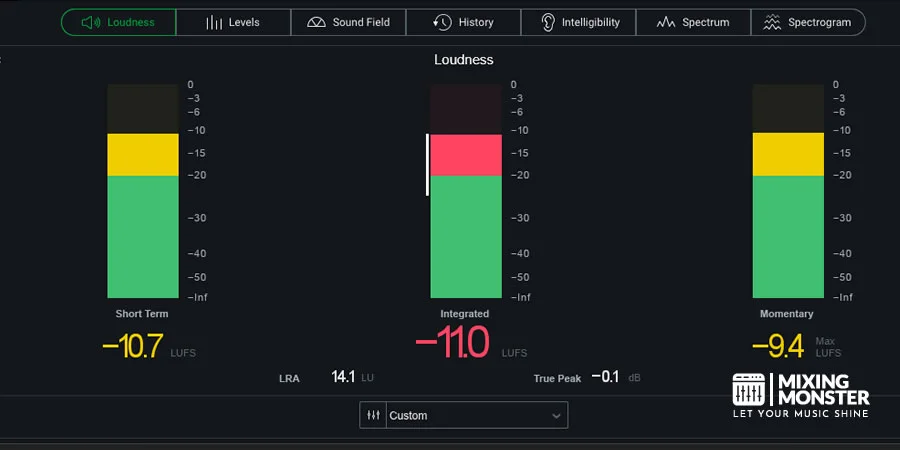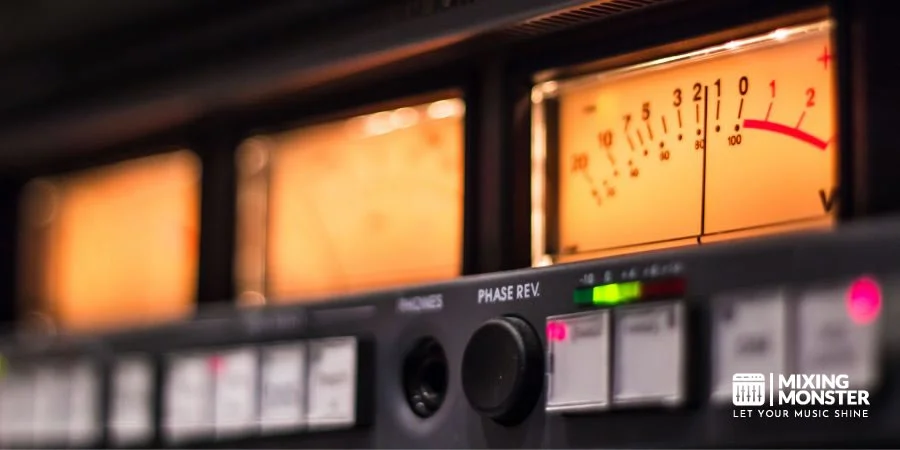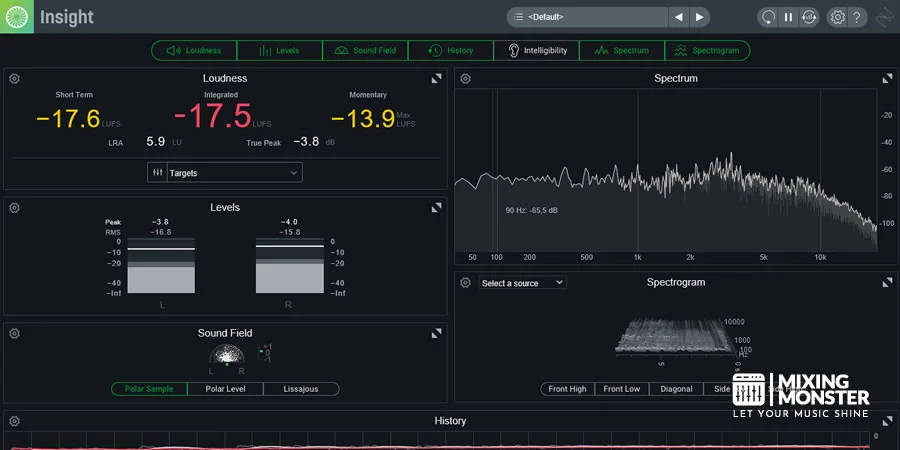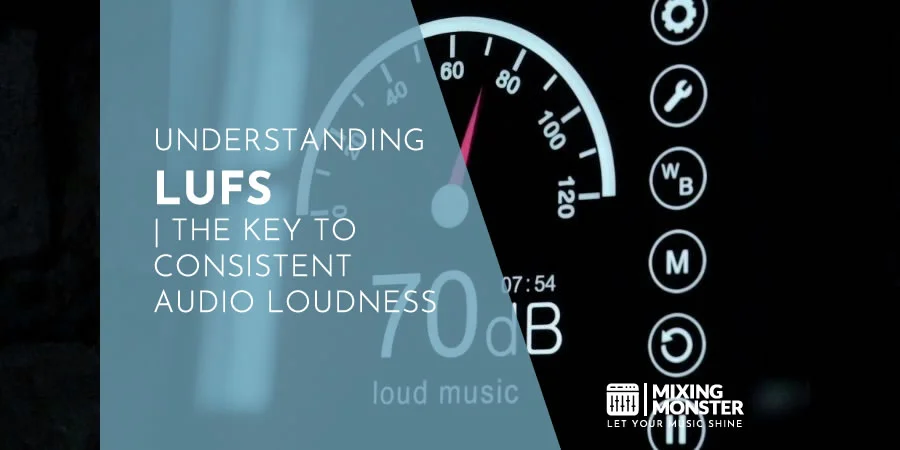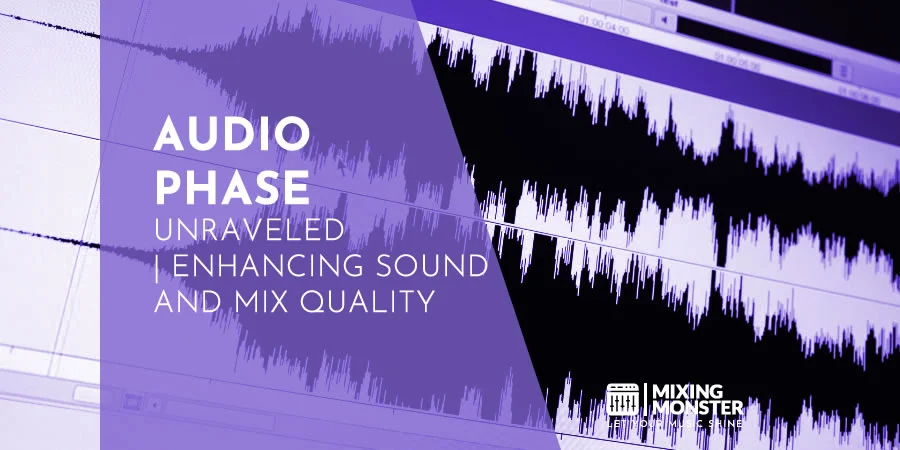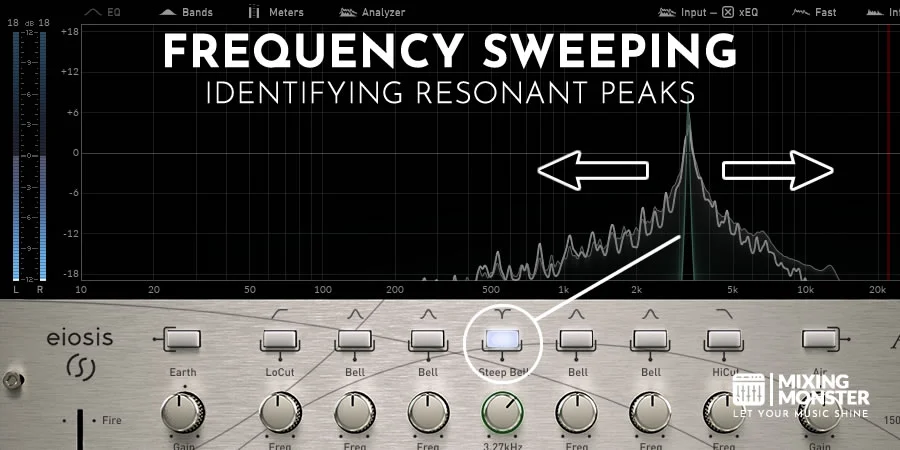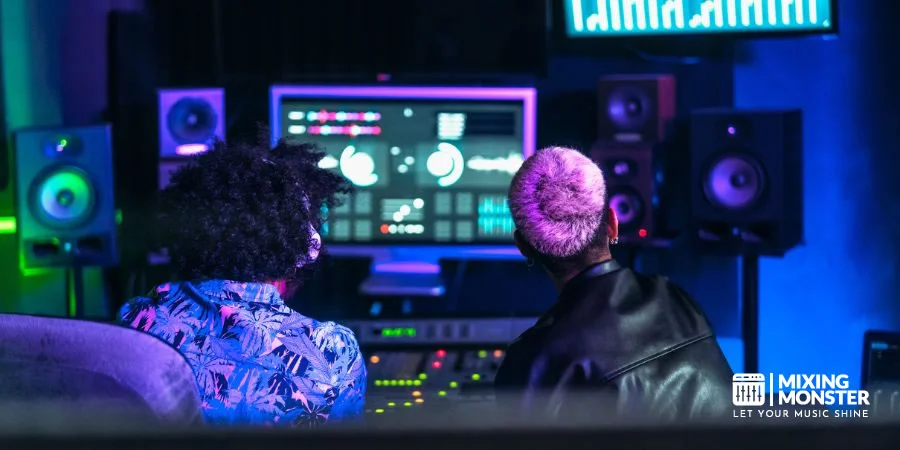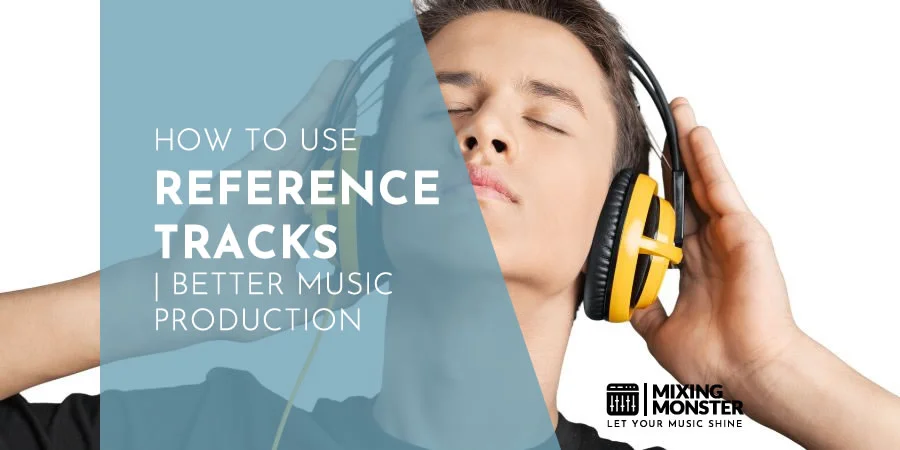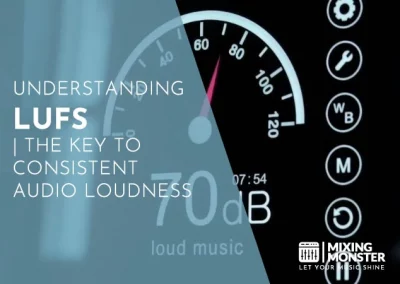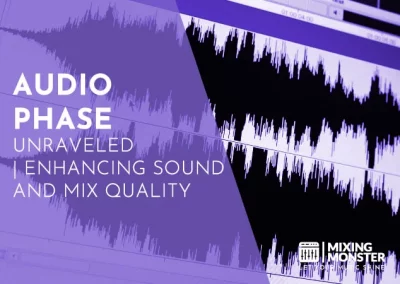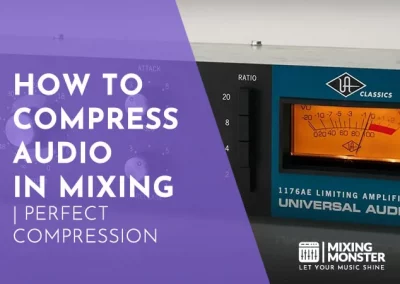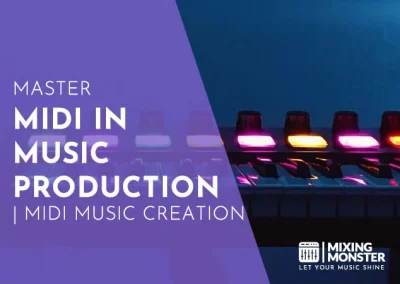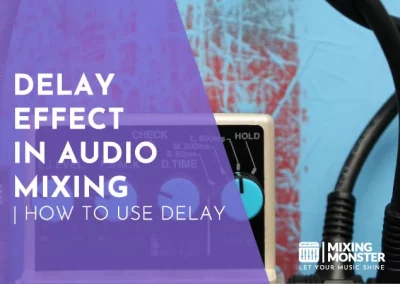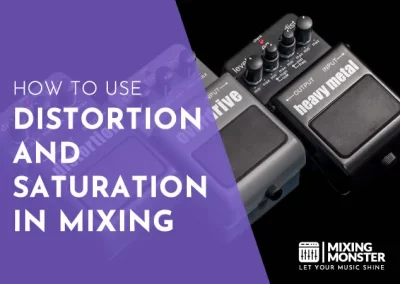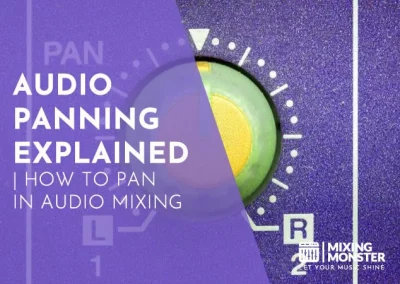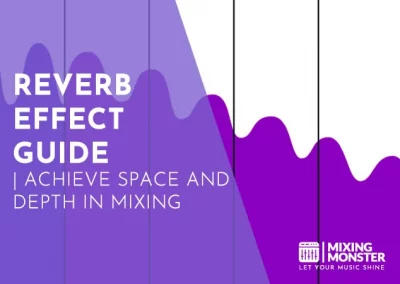Home > Blog > Mixing > Mixing Techniques
Affiliate Disclaimer: We may earn a commission if you purchase through our links
Audio metering, a crucial aspect of mixing and mastering, serves as the compass guiding audio professionals. In sound production, understanding the nuances of audio measuring is vital to achieving the perfect balance and clarity in your tracks. This article dives into the art and science of audio metering, unfolding its pivotal role in shaping the sound in music production.
Audio metering in music production ensures optimal sound quality by measuring audio values like loudness, RMS, true peak, phase correlation, and frequency spectrum. This process balances and enhances audio output for different playback systems.
In music production, the knowledge of audio metering becomes indispensable. This guide explores the technicalities and offers practical insights to measure audio correctly using proper audio meters.
Table Of Contents
1. What Is Audio Metering? A Comprehensive Overview
2. Audio Metering Hardware And Software
3. The Metrics Of Sound: Metering Audio Level Values
4. Advanced Audio Metering Concepts
5. Practical Audio Metering Strategies For Music Production
6. Listening Vs. Metering: Finding The Right Balance
7. Metering Reference Tracks For Perfect Mixes
8. Summarizing Audio Metering In Music Production
9. FAQ

1. What Is Audio Metering? A Comprehensive Overview
What Is Audio Metering?
Audio metering is a critical process in music production and sound engineering. It involves measuring and analyzing various audio elements such as loudness, dynamic range, and frequency balance.
Audio metering provides visual feedback to engineers and producers, helping them make informed decisions about mixing and mastering audio tracks. It combines science and art, requiring technical understanding and creative interpretation.
The Importance Of Audio Metering In Music Production
In music production, audio metering is a fundamental tool for ensuring that sound quality meets artistic and technical standards.
Whether balancing the loudness for streaming platforms or providing clarity and punch in a mix, audio metering guides the process. It helps identify issues like clipping, phase problems, and imbalanced frequencies, which can significantly impact the listener’s experience.
Critical Audio Values: Loudness, RMS, True Peak, And More
Key metrics in audio metering include loudness, RMS (Root Mean Square), and true peak levels.
Loudness meters provide insights into how the human ear perceives the intensity of sound, which is crucial for consistency across various playback systems.
RMS levels offer a more accurate representation of perceived loudness than peak meters.
True peak measurements, on the other hand, are essential for preventing digital clipping and distortion in the final output.
How Audio Metering Affects Sound Quality
Effective audio metering directly influences the quality of sound in a recording. Engineers can create great mixes on any system by accurately measuring and interpreting these audio values, from high-end speakers to smartphone earbuds.
It ensures the audio is balanced, dynamic, and free from technical flaws, resulting in a more enjoyable listening experience.
2. Audio Metering Hardware And Software
Comparing Audio Metering Hardware
When it comes to audio metering, hardware tools offer precision and reliability. The hardware used in studios varies greatly from classic VU meters to modern digital analyzers.
Each piece of hardware has its unique characteristics and applications. For instance, VU meters are excellent for getting a general sense of loudness and dynamics, whereas LED meters provide more precise peak readings.
The choice of hardware often depends on the audio project’s specific requirements and the sound engineer’s personal preference.
Essential Audio Metering Software
In the digital age, software solutions for audio metering have become indispensable. These software tools range from simple, free plugins to comprehensive, professional suites that comprehensively analyze every aspect of sound.
They are more versatile and accessible than hardware solutions, allowing engineers to visualize multiple aspects of audio simultaneously.
Some popular software audio metering tools include iZotope Insight, Waves Dorrough, and FabFilter Pro-L, each offering unique features for in-depth audio analysis.
Comparison Of Popular Audio Metering Software
| Software Name | Features | Best For |
| iZotope Insight | Extensive metering suite, Intuitive UI | Professional mixing and mastering |
| Waves Dorrough | Precise peak and loudness metering | Broadcast and post-production |
| FabFilter Pro-L | Advanced level metering, Real-time graph | Dynamic range optimization |
| Voxengo SPAN | Spectrum analysis, Stereo correlation | Frequency balance and analysis |
| TC Electronic LM2n | Loudness radar, True-peak metering | Consistent loudness monitoring |
How To Choose The Right Audio Metering Tools
Selecting the right audio metering tools is a balance between functionality, user interface, and budget. For beginners, starting with simpler, more intuitive software can be beneficial.
Investing in more sophisticated software or hardware becomes worthwhile as one’s skills advance. It’s also important to consider the compatibility of these tools with your existing audio setup, like your digital audio workstation (DAW) and the types of projects you usually work on.
Ultimately, the best tool is one you like to use, and that complements your workflow and enhances your ability to make sound decisions.
3. The Metrics Of Sound: Metering Audio Level Values
Metering Audio Loudness: What You Need To Know
Loudness metering is essential in ensuring your audio complies with industry standards, especially for broadcast and streaming services. Unlike peak meters, loudness meters measure the average level, better representing how the human ear perceives sound.
Loudness is often measured in LUFS (Loudness Units relative to Full Scale), a standard that helps maintain a consistent listening experience across different platforms and devices.
Understanding LUFS in audio loudness is crucial when learning about audio metering:
RMS In Audio Metering: Relevance In Music Production
RMS, or Root Mean Square, is another crucial metric in audio metering. It provides a more accurate depiction of perceived loudness than peak levels.
RMS metering is particularly useful in music production for balancing the levels of different tracks, ensuring that each element of the mix is heard clearly without overshadowing others. This measurement helps in achieving a well-balanced and cohesive sound.
Understanding True Peak In Audio Metering
True peak metering is vital for preventing digital clipping and distortion. True peak meters show the maximum level an audio signal reaches, including in the digital-to-analog conversion process.
This is crucial in digital audio, where exceeding 0 dBFS (decibels relative to full scale) can lead to distortion. True peak meters help engineers set appropriate headroom and avoid clipping, ensuring the final mix is clean and distortion-free.
4. Advanced Audio Metering Concepts
Measuring Phase Correlation In Audio
Phase correlation is a critical aspect of stereo imaging in audio production. It measures the relationship between a stereo mix’s left and right channels.
A phase correlation meter can indicate whether the two channels are in phase (working cohesively) or out of phase (which can cause phase cancellation and weaken the stereo effect). Proper phase alignment ensures a fuller, more robust stereo image and prevents issues in mono compatibility.
Want to learn more about audio phase? Here you go:
Frequency Spectrum Analysis In Audio Metering
Frequency spectrum analysis is crucial for identifying and addressing issues like frequency masking or imbalances in a mix. Spectrum analyzers display audio frequency content, allowing engineers to see which frequencies are dominant or lacking.
This tool is invaluable for tasks like EQ adjustments, where precise frequency tweaks can enhance the clarity and balance of the mix. Understanding the frequency spectrum is critical to achieving a mix that sounds good on all playback systems.

5. Practical Audio Metering Strategies For Music Production
Step-By-Step Guide To Audio Metering In Mixing
Audio metering in mixing is a step-by-step process that begins with correctly setting up your metering tools.
Start by calibrating your loudness meters to the desired reference level, typically -23 LUFS for broadcast or -14 to -16 LUFS for streaming platforms. Use RMS and true peak meters to ensure a balanced dynamic range and prevent clipping.
Regularly check the phase correlation to maintain a solid stereo image. As you mix, constantly refer to these meters to make informed decisions about levels, panning, and dynamics.
How To Apply Audio Metering
- Set Up Your Workspace:
Calibrate your studio monitors for accurate sound reproduction. Ensure your metering tools are visible and accessible in your digital audio workstation (DAW). - Begin With A Reference Level:
Set a reference loudness level suitable for your project (e.g., -23 LUFS for broadcast). Use a reference track to help set initial levels and EQ settings. - Analyze Initial Track Levels:
Play each track individually, observing the RMS and true peak levels. Adjust the levels to avoid clipping while maintaining a balanced mix. - Monitor Loudness Over Time:
Use a loudness meter to track the average loudness of your mix. Aim for consistent loudness, avoiding significant fluctuations. - Check Dynamic Range:
Observe the dynamic range meter to ensure your mix has sufficient contrast between loud and soft parts. Avoid over-compression, which can flatten dynamics. - Examine Stereo Imaging:
Use a phase correlation meter to check for phase issues between the left and right channels. Adjust panning and stereo enhancement tools to achieve a balanced stereo image. - Perform Frequency Spectrum Analysis:
Use a spectrum analyzer to identify frequency imbalances. Apply EQ adjustments to ensure a clear, well-balanced mix across all frequency bands. - Conduct A/B Comparisons:
Regularly compare your mix to the reference track. Adjust levels, EQ, and effects to match the quality and balance of the reference. - Final Loudness Optimization:
Adjust the final mix loudness to match your target LUFS. Ensure the mix meets the standards of your intended distribution platform. - Final Listening Session:
Listen to the entire mix in different environments (e.g., headphones, car stereo). Make final adjustments based on what you hear, not just what the meters show. - Document And Save Settings:
Note down essential metering settings and decisions for future reference. Save your session with clear labeling for easy recall.
Audio Metering In Mastering Explained
In mastering, audio metering takes on an even more critical role. The goal is to fine-tune the final mix to ensure it translates well across all playback systems.
This involves careful loudness normalization, dynamic range optimization, and frequency spectrum balancing. Use a combination of loudness, RMS, and true peak meters to achieve a consistent and commercially viable loudness level.
Pay close attention to the stereo image and frequency balance, making subtle adjustments to bring out the best in the mix.
Limiting audio plays a crucial role in loudness normalization:
Common Mistakes To Avoid In Audio Metering
A common mistake in audio metering is relying solely on visual feedback and neglecting the aural aspect. Trust your ears as much as your eyes!
Another mistake is setting the loudness levels too high, leading to a loss of dynamic range and an overly compressed sound.
Also, avoid ignoring phase issues, as they can severely affect your mix’s stereo spread and mono compatibility.
Best Practices For Audio Metering
Best practices in audio metering include regularly calibrating your meters, understanding the standards of your target medium (broadcast, streaming, CD, etc.), and continuously learning about new metering tools and techniques.
Always strive for a balance between technical precision and creative intuition. Remember, metering tools are there to guide you, but your ears are the final judge.
Best Practices For Audio Metering:
- Regularly calibrate your metering tools to ensure accuracy.
- Understand the loudness standards of your target medium (streaming, broadcast, etc.).
- Use a combination of meters (loudness, RMS, true peak) for a comprehensive view.
- Don’t rely solely on visual metering; trust your ears as much as your eyes.
- Keep up-to-date with the latest developments in audio metering tools and techniques.
- Practice critical listening to complement what you see on the meters.
- Avoid over-compression and maintain a healthy dynamic range in your mix.
- Use reference tracks to benchmark and guide your mixing and mastering.
6. Listening Vs. Metering: Finding The Right Balance
Aural Skills Alongside Visual Metering
Balancing aural skills with visual metering is essential in audio production. While meters provide objective, visual feedback on various aspects of the sound, they cannot replace the subjective experience and decision-making from critical listening.
Developing aural skills involves training your ears to detect subtleties in sound, like tonal imbalances, distortion, and stereo imaging issues. The goal is to use metering to inform and support your mixing and mastering decisions, but not dictate.
Integrating Critical Listening Into The Audio Metering Process
Integrating critical listening into the audio metering involves a dynamic interplay between what you see and hear. Start by setting levels and making initial adjustments based on meter readings. Then, listen critically to how these changes affect the overall sound.
Trust your ears to guide fine-tuning, using meters as checkpoints rather than targets. This approach ensures that the technical accuracy of your mix also meets artistic and emotional objectives!
7. Metering Reference Tracks For Perfect Mixes
Why Metering Reference Tracks?
Using reference tracks for metering is a powerful technique for achieving a professional-sounding mix.
Reference tracks are professionally mixed and mastered songs that serve as a standard or benchmark for your work. Analyzing these tracks with metering tools lets you gain insights into optimal loudness levels, dynamic range, and frequency balance.
This comparison helps you understand industry standards and guides you in adjusting your mix to align with these standards.
How To Analyze And Apply Audio Reference Track Data
To effectively use reference tracks, start by selecting a track that closely matches the genre and style of your music. Analyze the reference track using your metering tools, noting the loudness levels, dynamic range, and frequency spectrum.
Pay special attention to how the bass, midrange, and treble are balanced. Then, apply these observations to your mix to match the overall tonal balance and loudness.
Remember, the goal is not to copy but to use the reference as a guide for professional standards.
8. Summarizing Audio Metering In Music Production
Essential Concepts And Techniques In Audio Metering
Audio metering encompasses a range of techniques and concepts that are vital for high-quality sound production.
Understanding and applying metrics like loudness, RMS, true peak, phase correlation, and frequency spectrum analysis are crucial to creating a well-balanced and dynamic mix.
These concepts are not just technical requirements; they are the tools that allow audio professionals to bring their artistic vision to life with clarity and precision.
The Impact Of Accurate Audio Metering On Sound Quality
Accurate audio metering directly impacts the sound quality of a recording. It ensures that the audio meets the desired loudness standards, maintains dynamic integrity, and is free from issues like clipping and phase cancellation.
Good metering practices result in a final product that sounds great on any system, providing the listener with the best possible experience.
Best Metering Practices For Aspiring Audio Professionals
For aspiring audio professionals, mastering the art of audio metering is a journey that involves continuous learning and practice.
Staying updated with the latest metering tools and techniques, understanding the evolving standards of the audio industry, and, most importantly, developing a keen ear for sound is essential.
Remember, the best metering practice perfectly blends technical skills with creative intuition and intentional decision-making!
Happy metering!
9. FAQ
- What Is Audio Metering?
Audio metering is measuring various aspects of sound, such as loudness, dynamic range, and frequency balance, using specialized tools. It’s an essential part of audio mixing and mastering, providing visual feedback to engineers and producers for making informed decisions about the audio quality.
- What Is The Most Important Metric In Audio Metering?
While all metrics in audio metering are important, loudness is often considered crucial because it directly affects the listener’s perception of the audio. It’s measured in LUFS (Loudness Units relative to Full Scale) and ensures consistency across different playback systems.
- How Do Different Playback Systems Affect Audio Metering?
Different playback systems can vary in frequency response, dynamic range, and stereo imaging. Effective audio metering ensures that a mix sounds consistent and high-quality across various systems, from high-end studio monitors to consumer headphones.
- Can Audio Metering Improve The Listening Experience?
Proper audio metering can significantly improve the listening experience. It ensures that the audio is well-balanced, clear, and free from technical issues like clipping and distortion, making it more enjoyable for the listener.
- What Are common misconceptions About Audio Metering?
A common misconception is that visual metering alone is enough. In reality, it’s crucial to combine metering with critical listening. Another misconception is that louder is always better, which can lead to over-compression and loss of dynamics.


